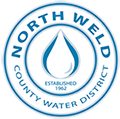The same natural forces that trigger cold-weather breaks in NWCWD’s mains can cause pipes to burst in your own household or business plumbing. Here are tips for avoiding costly damage.
Before Cold Weather Hits:
Know the location of your water shut-off valve and test it regularly. If a pipe breaks, you won’t want to have to find it then or, worse, wait for someone to arrive at your place and find it for you. In most single-family homes, the shut off valve is in the basement or the crawlspace on a wall facing the road or street.
Turn off and drain automatic and manual sprinkler systems before the first freeze. You’ll thank yourself in the spring. The alternate freezing and thawing of water in the system can create cracks and weak spots, triggering silent underground leaks or mini-geysers.
Turn off outdoor faucets and be sure to disconnect hoses from them. Make sure the faucet and the outside portion of the pipes are fully drained. A valve inside many houses will shut off the water’s flow; then open and close the tap outside to release any water in the pipe.
Disconnect the hose to assure that freeze-proof faucets will drain and to avoid hose damage.
Winterize unheated or vacant buildings. Significant property damage and water loss can occur before burst pipes are discovered in vacant buildings. If your vacant building has a fire protection system, make sure there is no danger that the water servicing this system might freeze.
Insulate water pipes that may be vulnerable to the cold or have caused problems before. Pipes close to exterior walls or in unheated basements can be wrapped with insulation. Don’t overlook pipes near windows which can quickly freeze. For particularly difficult pipes, consult a professional on how to select and apply heat tape. Caution: Improper use can cause fires.
Inspect your roof regularly for damage and remove debris from the roof and gutters. Ice dams are caused by melting snow above trickling down onto a colder section of your roof causing the water to freeze and create a dam. This dam can cause property damage. Remove the snow from your roof with a roof rake or push broom. Insulate and identify where the heat loss is occurring to make the roof more temperature consistent. Above all else – be careful!
Take it from us: Don’t fall into a winter cold snap unprepared. Prevent the property damage, repair bills and inconvenience of bursting household pipes.
During a deep freeze (-5 degrees below): Keep cabinet doors leading to exposed pipes open (such as access doors for sinks), so that household air can warm them. The natural flow of warmer air will help combat many problems. If you have an attached garage, keep its doors shut. Occasionally, plumbing is routed through this unheated space, leaving it vulnerable to winter’s worst. Crack a faucet farthest from the place where your water enters the house. A very slow drip will keep water molecules moving, reducing the chance that pipes will freeze. Place a bucket underneath the faucet so the water can be saved for other household uses. Keep your thermostat set above 65 degrees when leaving your house or business for several days.
If you think a pipe has already frozen: Don’t wait for nature to take it’s course: Thaw the pipe as soon as possible or call a plumber for help. If you do it yourself, shut off the water utilizing the valve in the house or crawlspace (call the District if you need the water at the meter shut off). You don’t want the water suddenly gushing from the pipe when it thaws.
Remember: When thawing things, slower is better: a hair dryer trained at the frozen area of the pipe is appropriate. A blow torch is not. Pipes warmed too fast may break anyway. Heat tape is a preventive measure and in most cases will not thaw frozen pipes.


